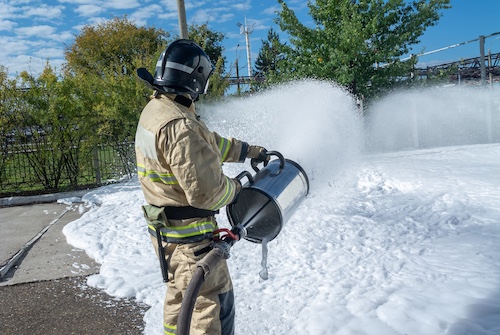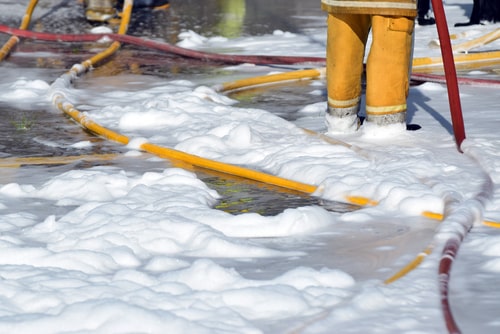The Hidden Cost of Firefighting Foam: Understanding AFFF Exposure Health Risks
For decades, Aqueous Film Forming Foam (AFFF) was used to fight fires involving jet fuel and other flammable liquids. While effective in emergencies, AFFF contains toxic PFAS chemicals that do not break down in the environment or the human body. These substances are now linked to serious health risks, including multiple cancers, thyroid disease, immune dysfunction, and microbial disruption. As scientific evidence grows, so do concerns for firefighters, military personnel, and communities exposed to PFAS through contaminated water and soil.
In this blog, we explain the health and environmental risks linked to AFFF exposure, review current scientific findings, and discuss why working with an experienced AFFF firefighting foam lawsuit attorney is important for those seeking financial compensation for PFAS-related illnesses.
What Is AFFF and Why Is It Dangerous?
Aqueous Film Forming Foam, or AFFF, has been used for decades in firefighting. It is effective for suppressing fires fueled by flammable liquids, but it contains toxic chemicals that pose serious health and environmental risks.
What Is AFFF?
AFFF stands for Aqueous Film Forming Foam. It is a synthetic firefighting foam used to extinguish fires involving jet fuel, gasoline, and other flammable liquids. AFFF forms a thin film on the surface of burning liquids to cut off the oxygen supply and cool the fuel.
This foam contains per and polyfluoroalkyl substances, also known as PFAS chemicals. These are synthetic compounds designed to resist heat, water, and oil. Because of these properties, PFAS chemicals do not break down easily and can remain in the environment for many years.
PFAS Chemicals and Human Health
The PFAS compounds in AFFF are often called “forever chemicals” because they stay in the environment and in the human body for long periods. These harmful chemicals can build up over time, increasing the risk of cancer and other severe health complications.
Studies have shown that PFAS exposure is linked to several health problems. These include kidney cancer, prostate cancer, testicular cancer, thyroid disease, and liver damage. PFAS chemicals interfere with hormone regulation and immune system function, potentially leading to chronic illness.
Environmental and Occupational Risks
AFFF use has resulted in widespread PFAS contamination in soil and drinking water, especially near military bases, airports, and fire departments. Firefighters, military personnel, and others involved in fire suppression activities face high PFAS exposure due to direct contact with the foam.
The Environmental Protection Agency (EPA) and the National Institute for Occupational Safety and Health (NIOSH) have identified AFFF as a major source of PFAS exposure. These agencies have warned about the increased risk of health issues in people exposed to PFAS-containing firefighting foam.
Summary of Health and Safety Concerns
AFFF may be effective for controlling fires, but it introduces significant health risks. PFAS exposure through AFFF is linked to cancer development, thyroid hormone disruption, pregnancy complications, and immune system problems. These risks make it important to understand the dangers of AFFF and support actions to limit further exposure.
Health Effects Linked to AFFF Exposure
AFFF exposure poses serious health risks due to the presence of PFAS chemicals, which accumulate in the human body and disrupt normal biological functions.
Cancers Linked to PFAS Exposure
Studies show that AFFF exposure increases the risk of several types of cancer. These include kidney cancer, testicular cancer, prostate cancer, bladder cancer, liver cancer, and thyroid cancer. Some research also links AFFF to breast cancer and colorectal cancer. Firefighters and individuals exposed to PFAS-containing firefighting foam have shown elevated rates of cancer compared to the general population.
The International Agency for Research on Cancer (IARC) classifies certain PFAS compounds, such as PFOA, as possibly carcinogenic to humans. Long-term exposure to these chemicals, often through occupational use or contaminated drinking water, has been identified as a major contributor to cancer development.
Endocrine and Thyroid Disruption
PFAS chemicals interfere with hormone production, particularly in the thyroid gland. This can lead to thyroid disease, thyroid cancer, and problems with thyroid hormone regulation. Disruption of the thyroid system may also contribute to fatigue, weight changes, and reproductive issues.
Pregnant women exposed to high PFAS concentrations may face increased risk of pregnancy complications, such as gestational diabetes and developmental problems in newborns. PFAS can pass through the placenta and affect the hormonal balance of the fetus.
Immune System and Digestive Impact
AFFF exposure has been linked to immune system suppression. Individuals with high PFAS exposure may have reduced vaccine response, frequent infections, and chronic inflammation. The chemicals also affect the digestive system, with links to ulcerative colitis and inflammatory bowel disease.
Some studies suggest that PFAS exposure alters gut microbiota, potentially leading to immune dysfunction and other serious health conditions. These changes may contribute to long-term health problems that affect multiple systems in the body.
Long-Term and Delayed Symptoms
Health effects from AFFF exposure may not appear immediately. Many individuals develop symptoms years after their initial contact with PFAS-containing firefighting foam. Common delayed symptoms include fatigue, hormonal imbalance, and eventually, a cancer diagnosis.
This long latency period makes it harder to trace the source of illness. However, increasing research and litigation efforts continue to connect these health problems to AFFF and its toxic components. Individuals who have been exposed should monitor their health and consult medical professionals for testing and guidance.
Microbial and Environmental Impact of AFFF Exposure
AFFF exposure affects not only human health but also environmental systems, including microbial communities that support water and soil quality.
Disruption of Soil and Water Microbial Life
PFAS contamination from AFFF affects bacteria in soil and groundwater. These microbes play a key role in breaking down waste and supporting plant growth. When exposed to PFAS compounds, microbial balance shifts. Some beneficial species die off while others become more dominant, leading to reduced soil fertility and water purification.
In areas near military bases and fire training sites, researchers have detected altered microbial communities in both surface and groundwater. This imbalance can affect nutrient cycles and water safety for surrounding populations.
Impact on Wastewater and Water Treatment Systems
PFAS chemicals in AFFF resist traditional water treatment methods. They are difficult to remove and can pass through filtration systems into drinking water supplies. Wastewater treatment plants are not equipped to filter out PFAS completely, allowing these synthetic chemicals to re-enter rivers, lakes, and groundwater.
This cycle of contamination contributes to long-term environmental exposure. The persistence of PFAS in water systems increases the chance of bioaccumulation in fish, plants, and humans, raising public health concerns.
Effects on Gut Microbiota and Human Health
Emerging research shows that PFAS chemicals may also affect microbial life inside the human body. Exposure to high PFAS concentrations can alter gut microbiota, which is essential for digestion, immune regulation, and disease prevention. These changes may contribute to inflammatory bowel disease, ulcerative colitis, and weakened immune responses.
Shifts in gut bacteria can also impact how the body processes other chemicals and drugs. This adds to the overall risk profile for individuals with prolonged or repeated contact with AFFF.
Long-Term Environmental Consequences
PFAS contamination from AFFF does not stay in one place. It moves through soil, water, and air, creating widespread environmental damage. These harmful chemicals accumulate in ecosystems and disrupt the natural balance of microbial populations. Over time, this weakens the resilience of the environment and increases health risks for nearby communities.
Cleaning up PFAS contamination is difficult and expensive. Because of this, prevention and strict regulation of PFAS-containing firefighting foam are key steps in reducing further environmental harm.
Contact an Experienced Mass Tort Attorney at Rueb Stoller Daniel ASAP!
If you or someone you care about has been exposed to AFFF and later diagnosed with cancer or another serious health condition, you may be entitled to financial compensation. The health risks linked to PFAS-containing firefighting foam are serious and well-documented. At Rueb Stoller Daniel, our team of experienced mass tort attorneys understands the impact of AFFF exposure and is committed to helping victims hold manufacturers accountable.
Contact us at 1-866-CALL-RSD for a free case consultation today!








